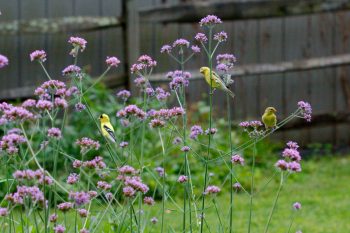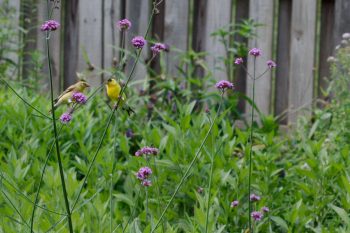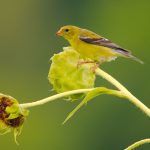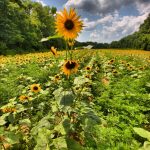We have a fair amount of Verbena bonariensis growing around the yard. It’s somewhat of a weed but for the most part, we let it go, just keeping it barely within bounds. There are a few reasons for us letting it go. First, of course, is that it’s pretty on its own. I mean, the purple adds a bit of contrast to all the green in the early summer and it’s generally still in bloom when the black-eyed Susans really start to go crazy. But I think the main reason is that the American Goldfinches (Spinus tristis) really seem to like it. Usually I’ve been unable to get close enough to get even a poor photo of them before they fly away but this afternoon I got a reasonable picture showing three finches. They are such lovely birds and we enjoy watching them bounce around on the tall stems of the Verbina.
Tagged With: Spinus tristis
American Goldfinches (Spinus tristis)
American Goldfinches (Spinus tristis)
There are some birds, notably the American robin (Turdus migratorius), that doesn’t really compare favorably with its European counterpart (Erithacus rubecula. While the European goldfinch (Carduelis carduelis) is a lovely bird, I think our American Goldfinch (Spinus tristis) is quite beautiful. This is a female (on the left) and male (on the right). They really love the Verbena bonariensis and it’s fun to watch them as they land and the stems bend under their tremendous weight. I enjoyed this couple for quite a while this morning.
McKee-Beshers Sunflowers and Birds
If the Kenilworth Aquatic Gardens are too much of a trek for you but you want flowers and birds, you could do worse than heading out River Road to the McKee-Beshers Wildlife Management Area. Timing your visit is a little difficult because the best time to go varies from year to year and also depends on what it is you want to see. If you just want sunflowers in bloom, then you need to go a little earlier than if you’re mostly interested in seeing birds. The two ‘seasons’ overlap but there will be more birds when the flowers have faded a bit and the seeds are more ripe. For me, I think I hit a pretty happy medium. In field number 1, the flowers were a little past and that’s where I got the pictures here of the indigo bunting (Passerina cyanea) and lots of pictures of American goldfinches (Spinus tristis).
Then, walking further from the parking area to field 4, I found the flowers were in more full bloom. They were all facing to the east and the road to them is to the west. From the road it looked like there were no flowers. But I walked all the way to the far end of the field (about a quarter mile) and back on the other side. It was worth it, as from that side, there were plenty of flowers to be seen. They were much shorter than I’ve seen them in previous years. I’m not sure if that’s a function of the sunflower varieties planted or has more to do with how much rain we get while they are growing.
American Goldfinch (Spinus tristis)
We drove out to McKee-Beshers this afternoon. We didn’t get out there when the sunflowers were blooming but thought we might see birds on the seedheads. We didn’t see indigo buntings (Passerina cyanea), probably because they are migrating south. We did, hovever see a lot of American goldfinches (Spinus tristis), like the one pictured here. I got a photo of a blue-gray gnatcatcher (Polioptila caerulea) and an eastern phoebe (Sayornis phoebe). At one area, where there are shallow ponds, we saw a green heron (Butorides virescens) and down by the river we saw a great blue heron (Ardea herodias).









